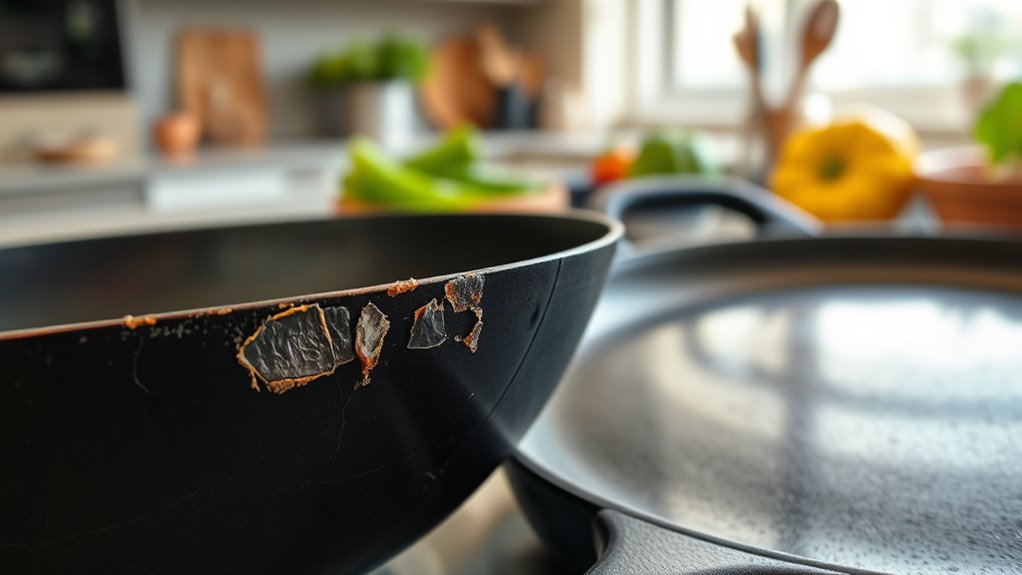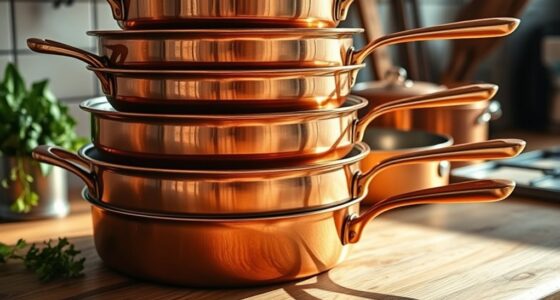Non-stick cookware often contains PFAS and PTFE coatings that can leach toxins into your food if scratched or overheated, posing health risks like hormone disruption and cancer. Heating above 250°C releases toxic fumes, and scratched surfaces release microplastics. Safer options include cast iron, stainless steel, or ceramic-coated pans, which are free of harmful chemicals and last longer. Want to discover how to switch to healthier cookware? Keep exploring to learn more.
Key Takeaways
- Traditional nonstick coatings contain PFAS and PTFE, which can leach toxic chemicals into food and release harmful fumes when overheated.
- Scratched nonstick pans release microplastics and nanoplastics, posing health risks and environmental pollution.
- Alternative materials like cast iron, stainless steel, and ceramic-coated cookware are free from PFAS and safer for health.
- Proper maintenance—avoiding high heat, abrasive cleaning, and using gentle utensils—extends the lifespan of safer cookware options.
- Choosing durable, chemical-free cookware supports a healthier kitchen and reduces exposure to persistent “forever chemicals.”
What Makes Traditional Nonstick Cookware Harmful?
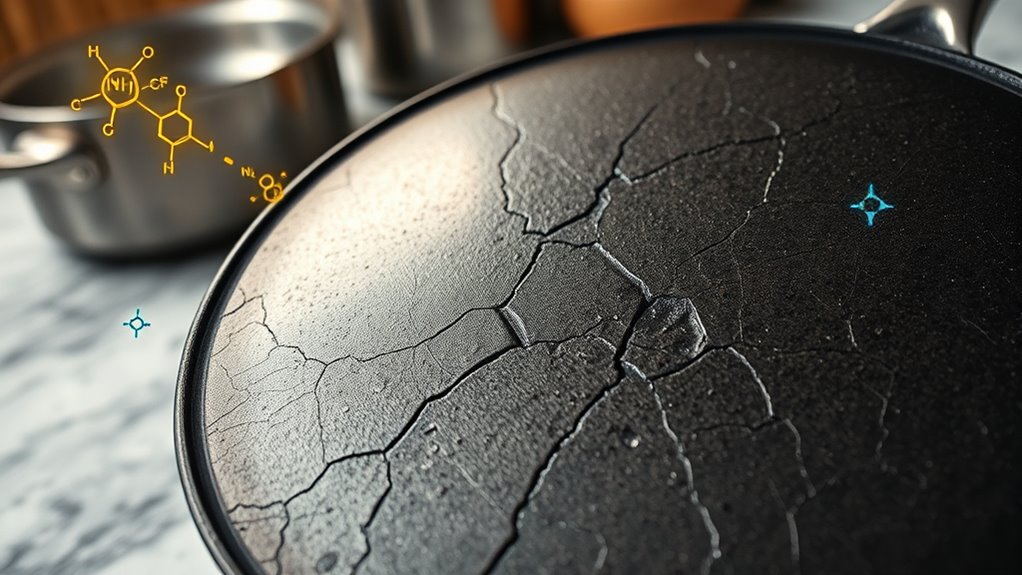
Traditional nonstick cookware can be harmful because its coating contains PTFE, a type of PFAS known as a “forever chemical” that can leach into your food if scratched or overheated. These nonstick coatings are designed to prevent sticking but pose health risks when damaged. When you heat nonstick pans above 250°C (482°F), they release toxic fumes that can cause flu-like symptoms and are deadly to birds. Scratched surfaces release microplastics, which you may ingest, potentially harming your respiratory health. Over time, these coatings degrade, releasing microplastics and possibly harmful chemicals into your food and environment. This ongoing chemical exposure is linked to health issues like thyroid disruption, immune suppression, and certain cancers. Scratched surfaces considerably increase these risks, making traditional nonstick cookware a health concern. Additionally, the degradation of nonstick coatings can lead to the release of harmful chemicals, further impacting long-term health.
The Hidden Dangers of PFAS and PTFE Coatings
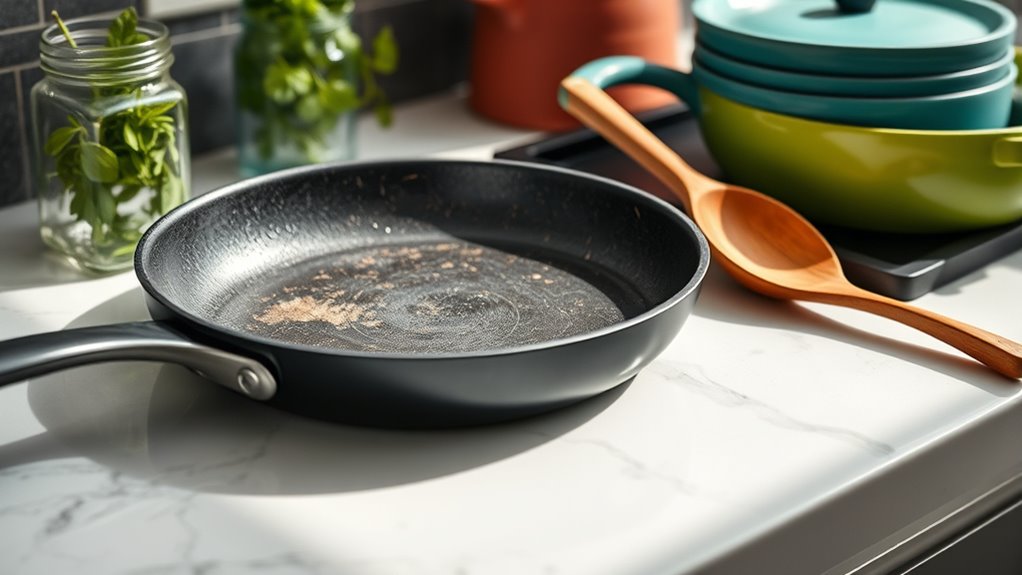
Many nonstick pans contain PFAS chemicals like PFOA and PTFE, which can leach into your food and the environment over time. These permanent chemicals are used in nonstick coatings to improve durability, but they pose serious toxicity risks. When you heat nonstick coatings above 250°C (482°F), PTFE can degrade, releasing toxic fumes and microplastic particles into the air and food. Scratches on the surface release nanoplastics and microplastics, which you may ingest unknowingly, potentially harming your respiratory health. PFAS are persistent “forever chemicals” linked to immune suppression, thyroid disruption, and increased cancer risk. Recognizing these dangers is essential, as high temperatures and wear make nonstick coatings a hidden source of toxic exposure that’s difficult to escape. Understanding chemical persistence underscores the importance of choosing safer cookware options.
How to Recognize Safe and Toxic Cookware Options
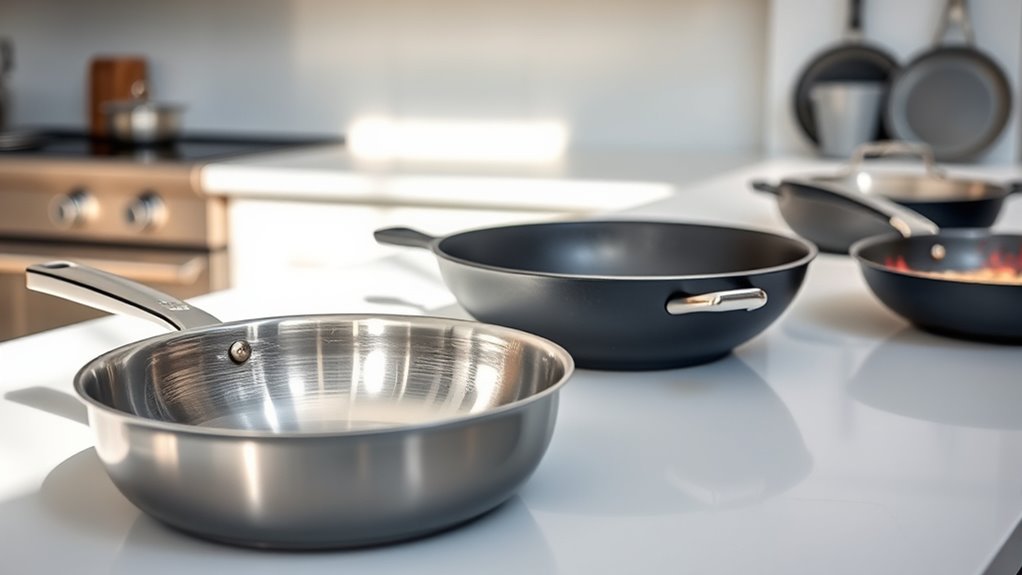
How can you tell if your cookware is safe or potentially toxic? Start by checking labels—look for “PFOA-free” and “PTFE-free,” but verify with independent testing or reputable sources, as labels can be misleading. Ceramic-coated pans and uncoated options like cast iron and stainless steel are proven to be free of PFAS and other harmful chemicals. Recent tests show many ceramic and uncoated pans contain no detectable PFAS, making them safer choices. Be cautious of scratched or damaged non-stick cookware, as deterioration can release microplastics and chemicals into your food. Also, consider the manufacturer’s transparency and third-party testing results to confirm your cookware truly avoids harmful substances. Choosing these options helps reduce your exposure to toxic chemicals and microplastics. Maximize space and organization by regularly assessing and rotating your cookware to prevent clutter and ensure safe, functional options are readily accessible. Additionally, being aware of how remote work environments can influence your kitchen organization and safety habits can promote a healthier cooking space. Understanding relationship patterns, such as communication lapses or repeated issues, can also help you make more informed choices about the tools and habits that support your well-being in the kitchen. Incorporating non-toxic cookware into your routine ensures a safer cooking environment for you and your family. To further ensure safety, look for cookware made from ceramic and uncoated materials, which are shown to be free of harmful chemicals in recent testing.
Best Practices for Using and Maintaining Nonstick Pans
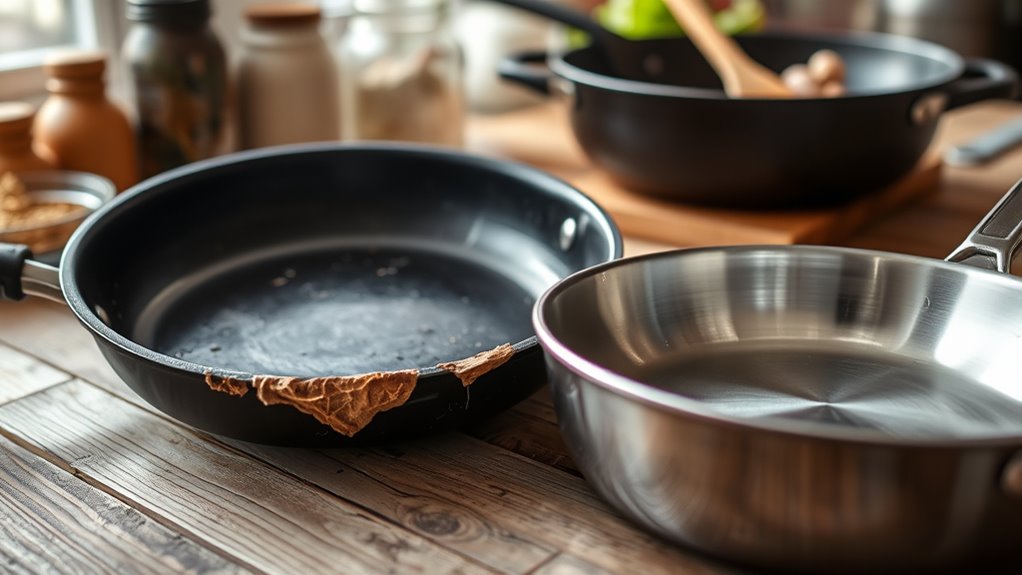
To extend the lifespan of your nonstick pans and minimize health risks, it’s essential to follow proper usage and maintenance practices. Use wooden, silicone, or plastic utensils to prevent scratches that can degrade nonstick coatings and release microplastics. Keep cooking temperatures below 250°C (482°F) to avoid damaging the PTFE coatings and releasing toxic fumes. Never preheat an empty pan, as high heat can quickly deteriorate the coating. Hand wash your nonstick cookware with gentle soap and soft tools—avoid abrasive scrubbers and dishwashers—to ensure damage prevention and prolong its performance. Regularly inspecting your cookware for coating deterioration helps identify when it’s time to replace it. Additionally, understanding nonstick coating materials can help you choose safer options and extend the usability of your cookware. Proper maintenance practices are crucial for maintaining nonstick integrity and safety. As AI continues to advance, new detection methods may emerge to better assess coating health, ensuring safer cooking experiences. Regularly monitoring your cookware for signs of wear and tear can prevent accidental ingestion of coating particles. Replace your pan once the coating shows scratches, cracks, or food begins sticking, usually every 2-3 years, to maintain safe cooking and prevent health risks.
Alternative Materials That Offer Natural Nonstick Performance
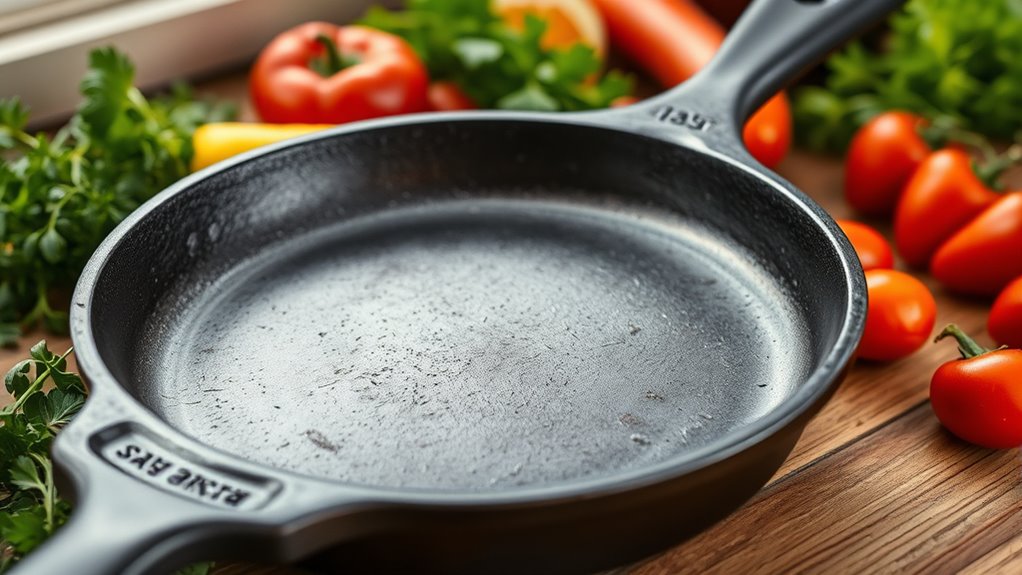
If you’re looking to avoid the potential health concerns associated with nonstick coatings, exploring natural nonstick materials can be a smart choice. Cast iron and carbon steel pans develop a natural nonstick performance through seasoning, creating a durable, chemical-free cookware surface. Properly seasoned pans can last decades and are environmentally friendly, offering high-heat cooking without chemical leaching. Ceramic-coated cookware provides a nonstick surface free of PFAS, silicon dioxide, and metal oxides, with no detectable chemicals in tests. Although initial cleaning requires effort, these options eliminate health risks linked to synthetic coatings. Additionally, material durability plays a significant role in choosing long-lasting cookware. When selecting cookware, considering safety and health is essential for peace of mind. Here’s a quick comparison:
| Material | Nonstick Performance | Environmental Impact |
|---|---|---|
| Cast Iron | Excellent when seasoned | Very eco-friendly |
| Carbon Steel | Similar to cast iron | Eco-conscious |
| Ceramic-Coated | Good, chemical-free | Environmentally friendly |
Resources to Learn More About Chemical-Free Cooking
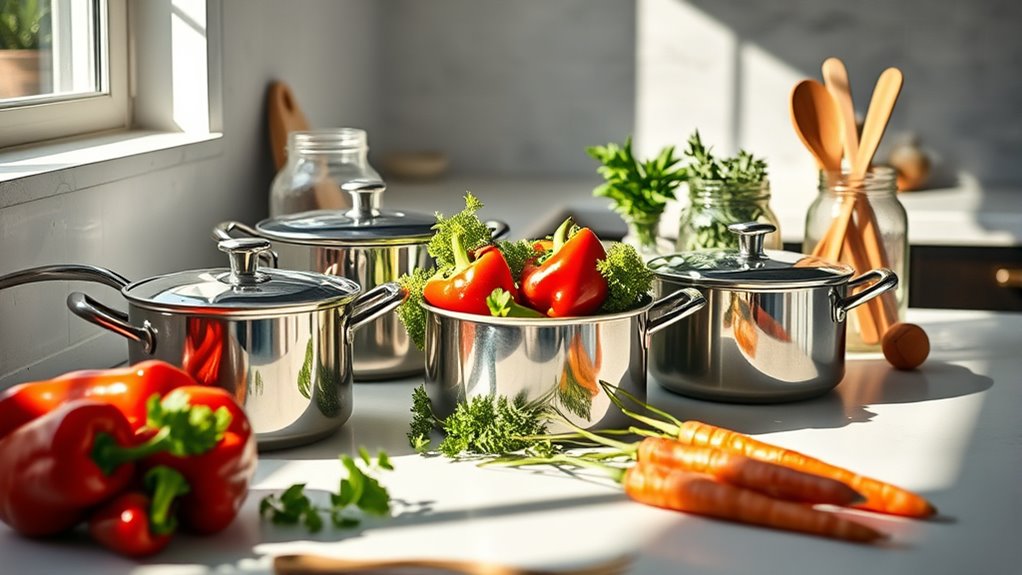
Exploring reputable resources can considerably enhance your understanding of chemical-free cooking and help you make safer choices. The Green Science Policy Institute offers a PFAS-Free products list and educational materials to identify non-stick cookware that avoids harmful chemicals like PTFE. The PFAS Central provides detailed insights into the health risks associated with PFAS and ongoing regulation efforts, helping you recognize safer options. The Agency for Toxics Substances and Disease Registry (ATSDR) shares information on PFAS health impacts and ways to reduce exposure through safer, eco-friendly cookware. Additionally, educational videos from trusted environmental organizations explain how to avoid PFAS in household items. These resources empower you to choose truly chemical-free, non-stick cookware that minimizes health risks and supports a safer, eco-conscious kitchen. Understanding regulatory efforts can further inform your choices by highlighting how government actions influence safer product availability. Recognizing the performance and safety features of non-stick alternatives can guide you toward more sustainable and health-conscious selections. Being aware of chemical safety standards ensures that you select cookware that aligns with health and environmental priorities. Moreover, exploring alternative materials like ceramic or cast iron can provide durable and non-toxic cooking options that meet your safety concerns.
Making the Switch for a Safer Kitchen Environment
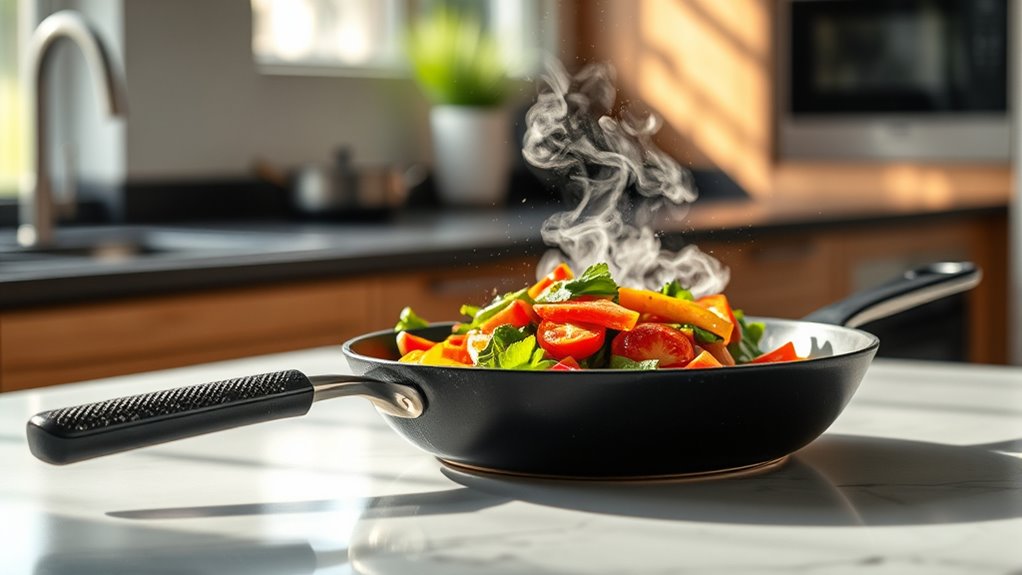
Switching to safer cookware options is a proactive step toward creating a healthier kitchen. Non-stick cookware often contains PFAS, which can pose toxicity risks and harm both your health and the environment. By choosing alternatives like cast iron, stainless steel, or ceramic pans, you eliminate exposure to these “forever chemicals” and reduce potential health hazards. Properly seasoned cast iron and well-maintained stainless steel provide nonstick performance without chemical risks, making them safer options. Replacing scratched or degraded nonstick pans also reduces microplastic and nanoplastic release into your food. Moving to toxin-free cooking materials enhances safety and peace of mind, especially when avoiding high-heat use that can release toxic fumes. Additionally, understanding contrast ratio can help you select cookware that performs better in your specific kitchen lighting conditions, ensuring optimal visibility and cooking precision. Incorporating creative problem-solving approaches, such as experimenting with different materials, can lead to discovering new safe and effective cookware solutions. Overall, switching to environmentally friendly alternatives promotes a safer, healthier kitchen environment.
Frequently Asked Questions
What Is the Best Replacement for Nonstick Cookware?
If you’re looking for the best replacement for nonstick cookware, consider cast iron or carbon steel pans. They develop a natural nonstick patina over time and are free of harmful chemicals. Ceramic-coated options are also great, offering nonstick performance without PFAS. Stainless steel pans work well too if you use proper heating techniques. These alternatives reduce your exposure to toxins and microplastics while still making cooking easy and effective.
What to Cook With Instead of Non-Stick?
When choosing what to cook with instead of non-stick pans, you should consider options like cast iron, stainless steel, or ceramic-coated cookware. Cast iron and carbon steel develop a natural nonstick patina over time, making them great for frying and sautéing. Stainless steel is durable and safe for browning and boiling. Ceramic-coated pans offer a non-toxic nonstick surface, perfect for easy food release without harmful chemicals.
What Is the Least Toxic Non-Stick Pan?
Think of your pan as a trusted partner in the kitchen. The least toxic non-stick options are ceramic pans and uncoated cast iron or stainless steel. Ceramic pans are like a clear lake—free of PFAS and trace chemicals—while cast iron and stainless steel develop a natural nonstick surface over time. Choosing these reduces chemical exposure, making your cooking safer and healthier without sacrificing performance.
Why Do Chefs Not Use Non-Stick Pans?
You might wonder why chefs avoid non-stick pans. They steer clear because high heat can damage the coatings, releasing toxic fumes. Plus, the non-stick surface wears out quickly, leading to peeling and potential food safety issues. Instead, they choose durable materials like stainless steel or cast iron, which tolerate high temperatures, last longer, and develop natural nonstick qualities over time. This guarantees safer, more reliable cooking.
What Is the Safest Cookware for Your Health?
Sure, you want the safest cookware for your health? Ironically, the safest options are often the ones your grandma used—cast iron and stainless steel. They’re free of harmful chemicals like PFAS. Ceramic-coated pans are also safe, as long as they’re PFAS-free. Uncoated pans develop natural nonstick surfaces without toxins. So, go old-school—your health will thank you, and you’ll enjoy cooking without worries about dangerous chemicals.
Conclusion
Switching to safer cookware can protect your health and your family. Imagine avoiding potential toxins like PFAS simply by choosing cast iron or ceramic pans instead of traditional non-stick options. For example, Sarah switched her old Teflon pans for ceramic ones and noticed her cooking improved without worrying about harmful fumes. Making small changes today guarantees a healthier kitchen environment tomorrow—because your well-being is worth it.
